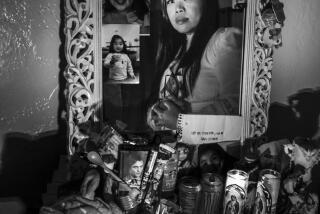‘Model’ Town Asks ‘Why?’ After Four Youths’ Suicide
BERGENFIELD, N.J. — Until this week, this closely knit community across the Hudson River from Manhattan liked to think of itself as a model for other small towns. The police department won prizes for its juvenile-assistance program, the high school romped away with the state football championship and the mayor expressed pride in the town’s 17 parks and public playgrounds.
Then, in a dramatic group suicide Wednesday morning, four teen-agers locked themselves in a garage and switched on the engine of their car. Thursday, under the unwelcome stares of reporters from around the nation, many of Bergenfield’s 25,000 people have been asking themselves what went wrong and how they can keep it from going wrong again.
Multiple Suicide Rare
Although “cluster suicides” are common in the United States--with one death triggering others in the same locale--a suicide pact such as this one among four teen-agers is rare. Their deaths followed four other suspected suicides by Bergenfield teen-agers in the last eight months.
What motivated Thomas Rizzo, Thomas Olton and sisters Cheryl and Lisa Burress to take their lives is unclear. What is clear, however, is that the elaborate safety nets put in place by Bergenfield’s conscientious leaders failed--the individuals most at risk already had fallen through.
The two boys and Cheryl Burress were beyond the reach of many juvenile-assistance programs because they had dropped out of Bergenfield High School. Lisa, 16, was suspended from the same school last month for reasons officials will not disclose.
School Criticized
At an emotional meeting at Bergenfield High School Thursday evening, parents and students accused the school of not doing enough to prevent dropouts. In addition, they criticized town authorities for failing to take action after the previous deaths.
“Why did eight people have to die for this town to get its act together?” asked a student who identified herself as Kim, a friend of the Burress sisters. She was loudly applauded.
Earlier in the day, police Lt. Donald Stumph, head of Bergenfield’s youth counseling program, said, “It may be that the kids we are reaching are not the kids who need us most.”
Stumph is proud of the town’s 32 juvenile-assistance programs--ranging from Adopt-a-Cop, aimed at elementary school children, to Project YES (Youth Environmental Services). But he acknowledges that the most troubled teen-agers usually are the most reluctant to approach adults with their problems--just as their parents are the least likely to attend parent-teacher meetings.
“As a community, we can provide shops, public schools, social services and sidewalks. But there are other things that are equally important, notably the home environment,” Stumph said.
Juvenile-assistance programs have mushroomed in recent years to cope with a tripling in U.S. teen-age suicides from 1950 to 1980. New Jersey has one of the nation’s lowest suicide rates.
Diane Ryerson, director of Bergen County’s Adolescent Suicide Awareness Program, said the crux of the problem is how to reach “alienated youth,” and she named high school dropouts and teen-age runaways as the groups most at risk.
“The dropouts don’t have a natural support system at school--and frequently not at home either. The one peer group they can always enter is the one that centers around drugs and alcohol,” she said.
More to Read
Sign up for Essential California
The most important California stories and recommendations in your inbox every morning.
You may occasionally receive promotional content from the Los Angeles Times.










